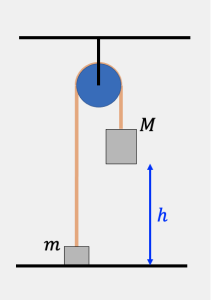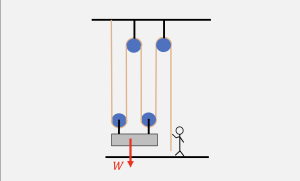30 Pulleys are Magic
Pulleys allow us to redirect forces. If you want to lift an object without a pulley, you have to pull up. But- with a pulley, you can tie a rope to the object, pass the rope through a pulley, and then pull down on the rope. That’s great, but obviously that is not why pulleys are magic.
Before discussing why pulleys are magic, though, we need to make sure we’re comfortable using them within the context of physics problems, so we will explore a classic: Atwood’s machine. If you are reading this because you have me as a professor, I will ask you to solve this exact problem as a quiz in our next class.
Exercise 30.1: Atwood’s Machine
 A pulley is attached to the ceiling as shown at right. Assume
A pulley is attached to the ceiling as shown at right. Assume ![]() , and that you release the heavy box form a height
, and that you release the heavy box form a height ![]() .
.
A. Find the upwards speed of the small box when the big box hits the ground.
B. Find the maximum height reached by the small box.
Hint: While the story of this problem is taking place, is the small box touching the floor? Use this to inform your force diagrams.
Now try making the drawing. If you get stuck, you can peak at my solution.
And now let’s bring it home: find relations and solve. Once again, make sure you try it yourself first!

I am well aware that the above problem was not exactly thrilling. But we haven’t gotten to the good part yet. What makes pulleys magic is that we can attach a hook to a pulley, and then hang stuff from it. A pulley that is meant to hang in this way is called a snatch block. You can see one of these at right.
Maybe that doesn’t sound especially exciting to you, but take a look at what happens when you use lift things up using one of these babies!
Exercise 30.2 : Pulleys are Magic!
Suppose you have to lift a very heavy box of mass ![]() . Being a brilliant physics student, you use a snatch block to make the rig shown below (do not use the slider to reveal my drawing yet).
. Being a brilliant physics student, you use a snatch block to make the rig shown below (do not use the slider to reveal my drawing yet).
How hard do you need to pull to lift the box?
Hint: notice the rope is pulling up on the pulley at two different spots.
If you get stuck, use the slider to reveal my force diagram in the picture above. You should be able to take it from there.
I also encourage you to check out the explanation from Smarter Every Day!
As it turns out, you can make things even more extreme by cleverly arranging additional pulleys and snatch blocks.
Exercise 30.3: This is crazy!

Consider the rig at right. What force ![]() must you apply if you wish to lift the weight
must you apply if you wish to lift the weight ![]() using this rig?
using this rig?
I’m going to stop here, since the basic physics insight that I wanted to get across is already done: pulleys are magic!
Warning: Later in class we will find out that once pulleys get involved the tension of the rope need not be constant across the whole rope. If the mass of the pulley is small, then the “constant tension” approximation remains valid. To understand this fully we need to wait until we learn about rotational forces, which won’t happen for a bit. For now, we will simply assume the tension of a rope is constant across the whole rope.
Key Takeaways
Snatchblock!
